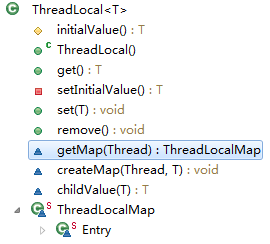ThreadLocal-分析-总结
ThreadLocal<T>类在Spring,Hibernate等框架中起到了很大的作用,对于其工作原理,很多网上的文章分析的不够彻底,甚至有些误解。
首先,为了解释ThreadLocal类的工作原理,必须同时介绍与其工作甚密的其他几个类(内部类)
1.ThreadLocalMap
2.Thread
可能有人会觉得Thread与ThreadLocal有什么关系,其实真正的奥秘就在Thread类中的一行:
- ThreadLocal.ThreadLocalMap threadLocals = null;
其中ThreadLocalMap的定义是在ThreadLocal类中,真正的引用却是在Thread类中
那么ThreadLocalMap究竟是什么呢?
可以看到这个类应该是一个Map,JDK的解释是
接下来的重点是ThreadLocalMap中用于存储数据的entry
- static class Entry extends WeakReference<ThreadLocal> {
- /** The value associated with this ThreadLocal. */
- Object value;
- Entry(ThreadLocal k, Object v) {
- super(k);
- value = v;
- }
- }
从中我们可以发现这个Map的key是ThreadLocal变量,value为用户的值,并不是网上大多数的列子key是线程的名字或者标识
到这里,我们就可以理解ThreadLocal究竟是如何工作的了
1.Thread类中有一个成员变量叫做ThreadLocalMap,它是一个Map,他的Key是ThreadLocal类
2.每个线程拥有自己的申明为ThreadLocal类型的变量,所以这个类的名字叫'ThreadLocal':线程自己的(变量)
3.此变量生命周期是由该线程决定的,开始于第一次初始(get或者set方法)
4.由ThreadLocal的工作原理决定了:每个线程独自拥有一个变量,并非共享或者拷贝
- /**
- * @author mxdba
- *
- */
- public class ThreadLocalSample {
- public static void main(String[] args) {
- ThreadTest test1 = new ThreadTest(10);
- ThreadTest test2 = new ThreadTest(20);
- test1.start();
- test2.start();
- }
- }
- /**
- * 此线程有两个ThreadLocal变量,但是由于ThreadLocal是延迟初始的,
- * 所以在debug时可以看到线程名为“线程20”的线程的ThreadLocalMap中没有thLcal2这个entry
- * @author mxdba
- *
- */
- class ThreadTest extends Thread {
- public static ThreadLocal<Integer> thLocal = new ThreadLocal<Integer>();
- public static ThreadLocal<String> thLocal2 = new ThreadLocal<String>();
- public Integer num;
- public ThreadTest(Integer num) {
- super("线程" + num);
- this.num = num;
- }
- @Override
- public void run() {
- Integer n = thLocal.get();
- if(num != 20) {
- String s = thLocal2.get();
- }
- if(n == null) {
- thLocal.set(num);
- }
- System.out.println(thLocal.get());
- }
- }
接下来分析一下源码,就更加清楚了
- /**
- * 关键方法,返回当前Thread的ThreadLocalMap
- * [[[每个Thread返回各自的ThreadLocalMap,所以各个线程中的ThreadLocal均为独立的]]]
- */
- ThreadLocalMap getMap(Thread t) {
- return t.threadLocals;
- }
- public T get() {
- Thread t = Thread.currentThread();
- /**
- * 得到当前线程的ThreadLocalMap
- */
- ThreadLocalMap map = getMap(t);
- if (map != null) {
- /**
- * 在此线程的ThreadLocalMap中查找key为当前ThreadLocal对象的entry
- */
- ThreadLocalMap.Entry e = map.getEntry(this);
- if (e != null)
- return (T)e.value;
- }
- return setInitialValue();
- }
- private T setInitialValue() {
- /**
- * 默认返回null,这个方法为protected可以继承
- */
- T value = initialValue();
- Thread t = Thread.currentThread();
- ThreadLocalMap map = getMap(t);
- if (map != null)
- map.set(this, value);
- else
- /**
- * 初次创建
- */
- createMap(t, value);
- return value;
- }
- /**
- * 给当前thread初始ThreadlocalMap
- */
- void createMap(Thread t, T firstValue) {
- t.threadLocals = new ThreadLocalMap(this, firstValue);
- }
通过上边的分析,我们发现,ThreadLocal类的使用虽然是用来解决多线程的问题的,但是还是有很明显的针对性
1.最明显的,ThreadLoacl变量的活动范围为某线程,并且我的理解是该线程“专有的,独自霸占”,对该变量的所有操作均有该线程完成!也就是说,ThreadLocal不是用来解决共享,竞争问题的。典型的应用莫过于Spring,Hibernate等框架中对于多线程的处理了
- private static final ThreadLocal threadSession = new ThreadLocal();
- public static Session getSession() throws InfrastructureException {
- Session s = (Session) threadSession.get();
- try {
- if (s == null) {
- s = getSessionFactory().openSession();
- threadSession.set(s);
- }
- } catch (HibernateException ex) {
- throw new InfrastructureException(ex);
- }
- return s;
- }
这段代码,每个线程有自己的ThreadLocalMap,每个ThreadLocalMap中根据需要初始加载threadSession,这样的好处就是介于singleton与prototype之间,应用singleton无法解决线程,应用prototype开销又太大,有了ThreadLocal之后就好了,对于需要线程“霸占”的变量用ThreadLocal,而该类实例的方法均可以共享。
2.关于内存泄漏:
虽然ThreadLocalMap已经使用了weakReference,但是还是建议能够显示的使用remove方法。
